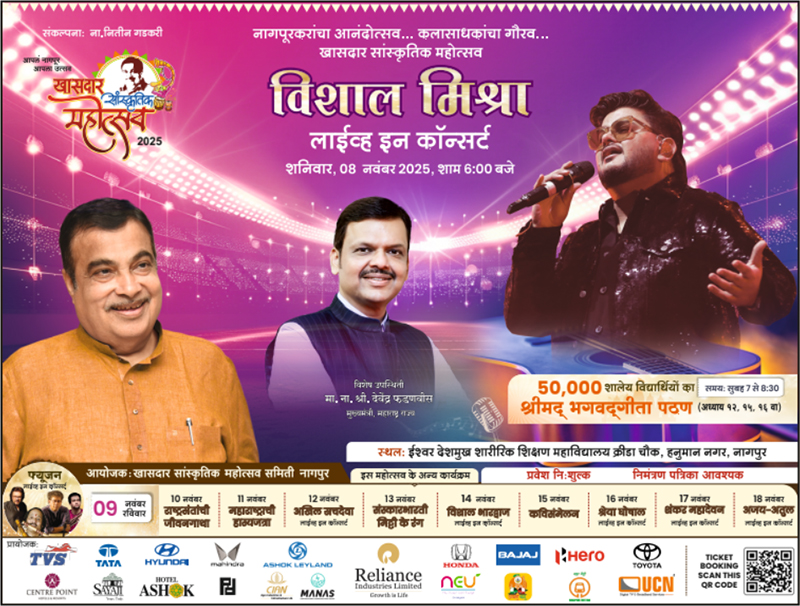Nagpur: On the Chindwara road from Nagpur is a small place called Jam Sawali, famous for a temple of a reclining Hanuman that is supposed to be ‘svayambhu’ i.e. self created. No one can tell how old the idol is -people believe that the Wonderful Sleeping Position of Lord Hanumana is Self-made from Peepal Roots.This temple is situated in a forest area, no more heavily forested now, but was once supposed to be full of medicinal plants. There is a fable that the Lord Rama is Standing in role Of Peepal tree and the Lord Hanuman is sleeping on his legs. The ‘form’ of Lord Hanuman may be ancient but a grand temple was built around it about 2 decades ago. The trust that controls the temple consists of Govt. officers like the local Collector.
It is a very popular destination for people from Maharashtra. During festivals like Hanuman Jayanti lakhs visit. Crowds are found every weekend too.
“90% of people coming for darshan are normally from Maharashtra” said a lady Police constable stationed there.
Among those who come here are also devotees in the search for ‘miraculous cures’ from physical infirmities that are considered incurable and patients who their relatives think are ‘under an evil spell’.
“Isko bhoot badha huyi hai…pishach peeche laga hai” one can hear sometime for someone whose strange ailments cannot be diagnosed or cured. The temple has banners and boards at entry point ‘advertising’ this point too.
Another unique feature of the temple is that it still does not allow women devotees in the inner sanctum santorum where Hanumanji slumbers, eyes open.
“Why?” We asked a priest.
“It is a Hanuman temple, he was a Brahmchari” is the reply we get. (Four ladies who went for a darshan, two from Nagpur, two from Mumbai.)
“Don’t you know the High Court of Mumbai has outlawed such discrimination?” We ask. The ‘pujari’ does not bother to reply; the lady constable says,
“don’t mind sisters! See, I have been deputed her for a long time now, even I can’t go in; senior lady officers, even judges and doctors come from Mumbai, they cannot go in either. Here, I will give you some coconuts, complimentary…” she pacifies us.
What the Mumbai High Court ruling was?
Hearing a PIL challenging the prohibition on women’s entry to the shrine area at Shani Shingnapur temple in Ahmednagar district in March 2016, the division bench of Chief Justice D H Waghela and Justice M S Sonak said: “You have to ensure their (women’s) access. Provisions in law already allow this. Nothing prevents women from entering. Police and collector will have to act against those preventing their entry.” It added that if men were granted entry to a place of worship, women should enjoy access too.
As per a 400-year-old tradition, women were not allowed to enter the Shani temple. After mass awareness campaigns, their entry was allowed in 2011, but they were prohibited from climbing the shrine platform.
Women are not allowed to climb the platform of Shani Shingnapur temple on which the rock idol of Shani is installed. Senior advocate Neelima Vartak and activist Vidya Bal have filed a PIL in the high court, arguing that such prohibition is arbitrary, illegal and in violation of fundamental rights of citizens. They have sought implementation of the Maharashtra Hindu Places of Public Worship (entry Authorisation) Act, 1956. The Act says, “no Hindu of whatsoever section or class shall in any manner be prevented, obstructed or discouraged from entering such place of public worship or from worshipping or offering prayers, or performing a religious service…”. As per the Act, prohibiting any person from entering a temple would attract six months in jail.
Referring to the Act, the court said: “It is your own law, you are obliged to uphold it.”
Unfortunately, there are a few other Hindu temples in other parts of India that still discriminate against women.
Main are:
Sabrimala Temple -Kerala
On March 21, 2016, Sabarimala temple authorities decided to regulate the presence of women of menstrual age in and around River Pampa during the ‘aarattu’ (ritualistic bath) ceremony on Mar 23. The Ayyappa idol is taken from the temple’s sanctum sanctorum for a holy dip in the Pampa river for ‘Aarattu.’
Though the entry of women is banned at the hillock shrine, there has been no restriction for women devotees in and around Pampa except at the ‘aarattu kadavu’, where the Lord takes holy dip, during the time of the ritual.
Patbausi Satra, Assam
Women are banned from entering this temple to preserve its ‘purity’. This temple also cites menstruation as the reason behind barring entry to women. In 2010, Assam Governor JB Patnaik, who was visiting the Patbausi, Sundaridiya, and Barpeta satras spoke with the authorities of the Patbausi satra and took a group of 20 women in. Following this, the satra was briefly open to women before the rule was eventually re-imposed.
Lord Kartikeya Temple, Pushkar
The temple worships the brahmachari form of Lord Kartikeya. There is a myth that the Lord curses women who enter the temple instead of blessing them. As a result, women are banned from entering the temple.
Ranakpur Temple, Rajasthan
This temple made entirely of carved white marble is a landmark and several Indian and international tourists visit it to admire its beauty and grandeur. However, a large board outside clearly defines when and how a woman can visit here. Again, women on their periods are asked to not enter the temple. It also has rules about wearing western clothes and accessories. The temple requires women to cover their legs till below their knees.
These are all old temples, with age old rituals which will take time to change.
But why should a reasonably new temple, in a “modern, progressive state” that M.P. now claims to be, still be regressive about this?
It is also funny, that women devotees are allowed to ‘view’ the Hanuman from about 15 feet away, from outside some metallic barricades. But inside only men can happily go!
Well, ‘Chamatkari Hanumanji” needs to show a ‘chamatkar’ and change this mind set!!! Did the real Hanuman discriminate between Ram and Sita? No, he idolized both equally. Time this one did too.
















